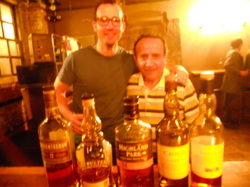 This camp still smells like a campfire, but that’s just the peat. And the only craft here is distilling. Welcome to Camp Whiskey. About 20 of us gathered in a Williamsburg bar basement last Wednesday for an introduction to the various regions of Scotland and what makes their whisky so damn tasty. Camp counselors Gary He, Jeff Galli, and Jonathan Wingo were already into the whisky conversation as the campers arrived.  Fellow campers. “This is a passion project,” said Galli, a bartender at Char No. 4 in Brooklyn, as he described the founding of the camp last summer. They wanted to get really good whiskey, and they didn’t want to drink alone. The best solution seemed to be creating a small community of people willing to pay a bit, learn a bit, and share in the good stuff. The fall session, Camp Whiskey’s second, will focus on Scotch. The crowd was laid-back, willing to shout out a question and curious for the gritty details of how American oak affects the flavor as compared to European oak – and fascinated by what happens when you mix the two. “We really like to nerd out,” said Wingo, who runs The Whiskey Shop in Williamsburg, Brooklyn. He also encouraged the group to be real. “You can talk shit about the whisky and say if you don’t like it.” That didn’t seem to be a problem – they had chosen 5 delicious bottles that we leisurely enjoyed while hearing them describe the effects of peat and barrels. We couldn’t pronounce most of the Scotch, but we could drink them. We started with Auchentoshan (12 year), a light whisky from the Lowlands that is triple distilled – unusual for Scotch, which is usually distilled twice. Next was rich, leathery Old Pulteney (12 year), a Highland Scotch. Here was where the location came out in the taste. Water near the sea can have a briny flavor, as in the case of Old Pulteney, which is produced in a fishing village. Scotch’s smoky smell comes from barley dried over a fire with peat, but Old Pulteney also has a hint of heather, which is one of the only plants that grows in the area and is added to the peat to give that whisky a more distinct taste. Highland Park (12 year) was an example of how the barrel affects the taste. They make their own sherry just to reuse the barrels for their Scotch. They also grow some whisky in American barrels and some in European barrels. And they use some peated and unpeated whisky. They mix all those factors to create the smoky balance that warms without overpowering.  Next stop was Islay and a Caol Ila (12 year), on the lighter side of smoky with coastal flavors – close your eyes and there is the salt from the air and seaweed. Caol Ila also happens to one of the whisky’s used in Johnny Walker, a blended Scotch. Another component in Johnny Walker is Dailuaine (16 year), which adds the rich quality to the blend. This was our final official stop in Scotland. And then we went to space. Not exactly, but Gary He did share some Ardberg Galileo with us. It is put out by Ardberg to commemorate their start of a new experiment “to test …micro organic compounds in a maturation experiment” in space. This is Camp Whiskey, where there is room for the unexpected. You don’t take home lanyards, but you don’t take home poison ivy rashes either. You do meet new friends and leave with good memories – that still have a whiff of campfire to them. Comments are closed.
|
Archives
November 2017
|

 RSS Feed
RSS Feed
